Tourism in Bangladesh
Tourism in Bangladesh is a developing foreign currency earner. The country was listed by Lonely Planet in 2011 as the "best value destination".[1]
Bangladesh's tourist attractions include, historical and monuments, resorts, beaches, picnic spots, forests and tribal people, wildlife of various species. Bangladesh offers ample opportunities to tourists for angling, water skiing, river cruising, hiking, rowing, yachting, sea bathing as well as bringing one in close touch with pristine nature.[2][3]
In the northern part, comprising the Rajshahi division, there are archaeological sites, including the temple city Puthia in Rajshahi; the largest and most ancient archaeological site, Mahasthangarh in Bogra; the single largest Buddhist monastery, Paharpur in Naogaon; the most ornamental terracota Hindu temple in Bangladesh Kantaji Temple, and many rajbaris or palaces of old zamindars.
In the south-western part, mainly the Khulna Division, there is the Sundarbans, the largest mangrove forest of the world with Royal Bengal Tiger and spotted deer. The historically and architecturally important sixty domed mosque in Bagerhat is a notable site.
In the south-eastern part, which is the Chittagong division, there are natural and hilly areas like Chittagong Hill Tracts, along with sandy sea beaches. The most notable beach, in Cox's Bazar, is a contender for the title of longest unbroken sandy sea beach in the world.[4]
In the north-eastern part, Sylhet division, there is a green carpet of tea plants on small hillocks. Natural reserved forests are great attractions. Migratory birds in winter, particularly in the haor areas, are also very attractive in this area.
Ministry of Tourism and The Civil Aviation Ministry designs national policies for the development and promotion of tourism. The Ministry also maintains the Beautiful Bangladesh campaign.

Economic impact
The World Travel and Tourism Council (WTTC) reported in 2013 that the travel and tourism industry in Bangladesh directly generated 1,281,500 jobs in 2012 or 1.8 percent of the country's total employment, which ranked Bangladesh 157 out of 178 countries worldwide.[5] Direct and indirect employment in the industry totalled 2,714,500 jobs, or 3.7 percent of the country's total employment.[5] The WTTC predicted that by 2023, travel and tourism will directly generate 1,785,000 jobs and support an overall total of 3,891,000 jobs, or 4.2 percent of the country's total employment.[5] This would represent an annual growth rate in direct jobs of 2.9 percent.[5] Domestic spending generated 97.7 percent of direct travel and tourism gross domestic product (GDP) in 2012.[5] Bangladesh's world ranking in 2012 for travel and tourism's direct contribution to GDP, as a percentage of GDP, was 142 out of 176.[5]
Chittagong division
The city of Chittagong has many high end, private hotels such as the Hotel Agrabad, the Hotel Well Park Residence, The Peninsula Chittagong, the Hotel Harbour View, the Hotel Meridian, and Avenue Hotels and Suites.
The JW Marriott, Westin and Radisson Blu are among the upcoming five-star hotels in Chittagong city.[6][7][8]
Chittagong Hill Tracts division
The Chittagong Hill Tracts (CHT) comprise an area of 13,180 square kilometres (5,090 sq mi) in southeastern Bangladesh. CHT includes the Rangamati, Khagrachari, and Bandarban districts and is home to the country's largest concentration of at least 11 different ethnic groups and is a unique part of the country both in terms of landscape and its people.[9] The ethnic groups are bound together by a shared history, years of peaceful cohabitation, and a common future. They differ from the majority Bengali population of Bangladesh in their physical features, culture, and religion. However, nearly all the tribal peoples also include traditional tribal elements in their formal religious beliefs and practices.[10]
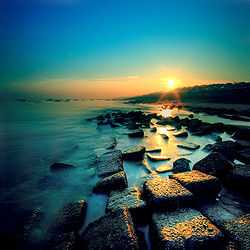
Patenga beach
A tourist attraction near Patenga beach is the Butterfly Park.[11]

Foy's Lake
Foy's Lake is a human-made lake in Chittagong, Bangladesh. The lake was once just a lake and spillway constructed by Assam-Bengal Railway engineer. It was dug in 1924 and was named after the English engineer Mr. Foy.[12] The lake is next to Batali Hill, the highest hill in Chittagong Metropolitan area. An amusement park, managed by the Concord Group, is located here.[12]

Heritage Park
There is a heritage park called Shaheed Zia Memorial Complex and Mini Bangladesh at Chandgaon which reflects the most notable structures and instances of Bangladesh. This 71-metre tower in Mini Bangladesh in Chittagong has a restaurant on the top that rotates once every 90 minutes.[13] The museum includes a revolving restaurant. One can perceive of the country's architectural beauty, ethnic traditions and archaeological inheritance through having a glimpse of the heritage park. Replica of major structures of the country, includes Jatiya Sangsad Bhaban (parliament building), National Memorial of Savar, Ahsan Manzil, Curzon Hall of Dhaka University, Paharpur Monastery, Kantajew Temple of Dinajpur, Lalbagh Fort and Sona Masjid. The park also has different rides for children.[14]

Ethnological Museum of Chittagong
The Ethnological Museum of Chittagong located in Agrabad, established in 1965, is the only ethnological museum in the country. It offers the visitors the chance to acquaint with the lifestyles and heritage of various ethnic groups of the country. The museum authority had collected rare elements used in everyday lives of different ethnic groups, of which some had already become extinct while some were on the verge of extinction. The museum contains four galleries and a small hall. Three galleries of the museum feature diverse elements of twenty nine ethnic groups in Bangladesh, while the rest of the gallery displays the lifestyles of some ethnic groups of India, Pakistan and Australia.[15]
WWII cemetery and Circuit House
The War Cemetery on Badshah Mia Road contains the graves of 755 soldiers, and is protected and maintained by the Commonwealth War Graves Commission.[16] There are a number of museums in Chittagong. The most prominent is the Zia Memorial Museum which is housed in the old circuit house building. President Ziaur Rahman was assassinated there on 30 May 1981. This commemorative museum houses the Late President Ziaur Rahman's mementos and personal belongings. It was established in 1993 with 12 galleries.[17]
Dhaka division
Dhaka Division is an administrative division in Bangladesh. Dhaka ( formerly "Dacca" Bengali: ঢাকা ) is the largest and capital city of Bangladesh. eDailylife is trying publish the list of all important and famous tourists destinations in Dhaka division.

Lalbagh Fort

Lalbagh Fort is an incomplete 17th century Mughal fort complex in Dhaka, Bangladesh.[12]
Ahsan Manzil

Ahsan Manzil (Bengali: আহসান মনিজল, Ahsan Manzil) is a wonderful ancient building, located on the bank of the river Buriganga, in old Dhaka at Kumartoli, Islampur area. It was a residential palace for Dhaka Nawab Family. The structure of this palace was started in the year 1859 and was finished in 1869.[18]
Shaheed Minar

The Shaheed Minar (English:Martyr Monument) is a national monument in Dhaka, Bangladesh, established to commemorate those killed during the Bengali Language Movement demonstrations of 1952.
On 21 February 1952, dozens of students and political activists were killed when the Pakistani police force opened fire on Bengali protesters who were demanding equal status for their native tongue, Bengali. The massacre occurred near Dhaka Medical College and Ramna Park in Dhaka. A makeshift monument was erected on 23 February[19] by students of University of Dhaka and other educational institutions, but demolished on 26 February[20] by the Pakistani police force.
The Language Movement gained momentum, and after a long struggle, Bengali was given equal status with Urdu. To commemorate the dead, the Shaheed Minar was designed and built by Hamidur Rahman, a Bangladeshi sculptor. The monument stood until the Bangladesh Liberation War in 1971, when it was demolished completely during Operation Searchlight. After Bangladesh gained independence, it was rebuilt.
At present, all national, mourning, cultural and other activities held each year, regarding 21 February, have been centered around the Shaheed Minar.
Jatiya Sangshad
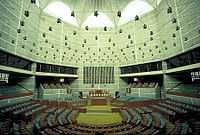
(National Parliament – Bengali: জাতীয় সংসদ ভবন): Jatiyo Sangsad Bhaban was created by American architect Louis I. Kahn. Construction was started in 1961 and completed on 28 January 1982 with the total cost was about 32 million dollars. It is situated at Shre-e-Bangla Nagar in Dhaka. Jatiyo Sangsad Bhaban was used for the first time on 15 February 1982 as the venue for the eighth (last) session of the second parliament of Bangladesh. Since then, it has been used for the Bangladesh National Assembly.[21]
Rajshahi division
.jpg)
Somapura Mahavihara

Somapura Mahavihara in Paharpur, Badalgachhi Upazila, Naogaon District was designated a UNESCO World Heritage Site in 1985.[22]
Varendra Research Museum
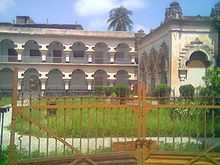
Varendra Museum is a museum, research center and popular visitor attraction located at the heart of Rajshahi town and maintained by Rajshahi University in Bangladesh.
Bagha Mosque
According to an inscription on the mosque’s central entrance, bagha Mosque was Built by Sultan Nusrat Shah in 1523 A.D. Bagha Mosque is a richly decorated monument originally roofed over with 10 domes which collapsed long ago. It is built of bricks with stone plinth, lintels and pillars.But recently this Mosque rebuilt carefully to their original form.The inscription is now preserved in Karachi, Pakistan.
Barisal division
Kuakata Beach
Kuakata is a panaromic sea beach on the southernmost tip of Bangladesh. Located in the Patuakhali district, Kuakata has a wide sandy beach from where one can see both the sunrise and sunset.
Sylhet division
Jaflong

Jaflong is a natural tourist spot in the Division of Sylhet, Bangladesh. It is located in Gowainghat Upazila of Sylhet District and situated at the border between Bangladesh and the Indian state of Meghalaya. It is just below the mountain range. Jaflong is famous for its stone collections and is home of the Khasi tribe.
Architecture
Religious
Bangladesh has many places of worship. Capital Dhaka is known as the city of mosques.
Some famous Religious Place of Worships and visitor attractions are:

- Baitul Mukarram is the national mosque of Bangladesh. Located at the center of Dhaka, the mosque was completed in 1968. The mosque has a capacity of 30,000, and it is world's tenth largest mosque.
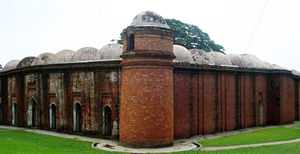
- Mosque City of Bagerhat is a formerly lost city, located in the suburbs of Bagerhat city in Bagerhat District, in the Khulna Division. The historic city, listed by Forbes as one of the 15 lost cities of the world, has more than 50 Islamic monuments.
.JPG)
- Kantojiu Temple built between 1702 and 1752, a nava-ratna (nine-spired) style hindu temple.
- Dhakeshwari Temple built in the twelfth century, a hindu temple.
- Hoseni Dalan a Shia shrine built in the seventeenth century.
- Sixty Dome Mosque is a mosque in Bangladesh, the largest in that country from the Sultanate period. It has been described as "the most impressive Muslim monuments in the whole of the Indian subcontinent."
Ancient ruins
- Wari-Bateshwar ruins, built in 450 BC, 2500 years old ancient fort city
- Somapura Mahavihara is a Buddhist monastery situated in the Rajshahi District in the north of Bangladesh. Covering almost 27 acres of land, Somapura Mahavira is one of the largest monasteries south of the Himalayas. The design is considered to be greatly influenced by Buddhist architecture found in Java and Cambodia.[23]
- Mainamati is an isolated ridge of low hills in the eastern margins of deltaic Bangladesh, about 8 kilometres (5.0 mi) to the west of Comilla town. A landmark of ancient history, it represents a small mass of quasi-lateritic old alluvium. The ridge, set in the vast expanse of the fertile lower Meghna basin, extends for about 17 kilometres (11 mi) north-south from Mainamati village on the Gumti River to Chandi Mura near the Lalmai railway station.[24]
The oldest archaeological site in Bangladesh is outside Bogra, at Mahasthangarh.
Middle Age
- Sonargaon was the administrative center of medieval Muslim rulers in East Bengal.

- Lalbagh Fort Lalbagh Fort or Fort Aurangabad, an incomplete Mughal palace fortress at Dhaka on the river Buriganga in the southwestern part of the old city. The fort was considered to be a combination of three buildings (the mosque, the tomb of Bibi Pari and the Diwan-i-Aam), two gateways and a portion of the partly damaged fortification wall.[25]
- Ahsan Manzil was previously the official palace of the Dhaka Nawab family and is currently a museum preserving the culture and history of the area.Ahsan Manzil is considered to be one of the most noteworthy architectural monuments in Bangladesh.[26]
- Bara Katra an architectural relic of Dhaka city. It is situated to the south of Chawk Bazar close to the bank of the river buriganga.The Katra enclosed a quadrangular courtyard with 22 rooms on all of its four sides.[27]
British architecture
- Curzon Hall a hundred years old biritsh style town hall.
- Northbrook Hall a hundred and fifty years old Biritsh style town hall.
Modern
- Bangladesh National Museum Located in the suburb of Shahbag, in the city of Dhaka, is the biggest museum in Bangladesh. It has a collection of over eighty five thousand pieces. The four-storey building is home not only to large exhibition halls, but to a conservatory laboratory, library, three auditoriums, photographic gallery, temporary exhibition hall, and an audio-visual division.[28]
- Jatiyo Sangshad Bhaban Parliamentary Building of Bangladesh, located in Dhaka. It was created by architect Louis Kahn and is one of the largest legislative complexes in the world. It houses all parliamentary activities of Bangladesh.
- Taj Mahal Bangladesh is a Bangladeshi artictecture inspired from original Taj Mahal
Historic monuments
- Greek Memorial is an ancient monument, built in around AD 1900, looks like ancient Greek temples, a small yellow structure on land owned by the Greek Community, which flourished in Dhaka in the 19th century.
- National Martyrs' Memorial is the national monument for the Bangladesh Liberation War of 1971
- Martyred Intellectuals Memorial is a memorial built in memory of the martyred intellectuals of the Bangladesh Liberation War.
- Suhrawardy Udyan formerly known as Ramna Race Course ground is a national memorial located in Dhaka. It is named after Huseyn Shaheed Suhrawardy.
- Mosque City of Bagerhat is a formerly lost city, located in the suburbs of Bagerhat city in Bagerhat District, in the Khulna Division of southwest of Bangladesh and UNESCO World Heritage Site.
- Ahsan Manzil was the official residential palace and seat of the Dhaka Nawab Family. This building is situated at Kumartoli along the banks of the Buriganga River in Dhaka.
- Zia Memorial Museum is housed in an interesting mock-Tudor mansion. Among its collection is the microphone and transmitter with which President Shaheed Ziaur Rahman proclaimed the country’s independence in 1971, and you can see the blood-stained and bullet-damaged wall at the foot of the stairs where Zia was shot.
- Lalbagh Fort is an incomplete seventeenth century Mughal fort complex in Dhaka. The construction was started in 1678 AD by Mughal Subahdar Muhammad Azam Shah.
- Shiva Temple in Puthia consists of a cluster of notable old Hindu temples in Puthia Upazila, Rajshahi Division, Bangladesh.

Nature tourism
Bangladesh has geographical diversity, which resulted in varieties of nature tourism.
- The Sundarbans is the largest single block of tidal halophytic mangrove forest in the world and has also been enlisted among the top 14 finalists in the New7Wonders of Nature.
Wildlife in Bangladesh

Bangladesh is home to several well-known mammals including the Bengal Tiger, the Asian Elephant, the Hoolock gibbon, and the Asian Black bear. The country has roughly 53 species of amphibian, 19 species of marine reptiles, 139 species of reptiles, 380 species of birds, 116 species of mammals, and 5 species of marine mammals. In addition to the large bird count, a further 310 species of migratory birds swell bird numbers each year. The vast majority of these creatures currently dwell in an area of land that is approximately 150,000 square kilometres (58,000 sq mi) in size. The dhole, also called the Asiatic wild dog, is now endangered by habitat, prey-species loss, and human persecution. Notable animal species that have disappeared from Bangladesh are the one- and two-horned Rhinoceros, the Gaur, the Banteng, Swamp deer, Nilgai, Indian Wolf, wild Water Buffalo, marsh crocodile and common Peafowl.
The world's largest mangrove forest Sundarbans is located in Southwestern Bangladesh. Sundarbans National Park are UNESCO World Heritage Site.
Hill stations

- Bandarban, Chittagong
- Khagrachori, Chittagong
- Rangamati Hill District
- Jaflong, Sylhet
- Sripur, Sylhet
- Srimangal county, Sylhet
Lakes
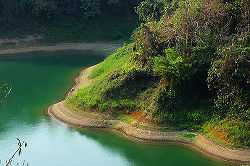
Beaches
Bangladesh offers a wide range of tropical beaches. Cox's Bazar is known for its wide and long sandy beach which is considered as the world's longest natural sandy sea beach. Some of the other famous tourist beaches are:
Islands

The islands of Bangladesh are scattered along the Bay of Bengal and the river mouth of the Padma. There are more than 30 islands in Bangladesh. Some famous tourist attractions are:
- St. Martin's Island, St. Martin
- Chhera Island,St. Martin
- Bhola Island, Bhola
- Manpura Island
- Nijhum Dwip, Noakhali
- Sandwip Island, Chittagong
- Sonadia Island, Chittagong
Shopping

While muslin of ancient Dhaka has gone into history, other products such as contemporary paintings, wood works, shital pati (mats that feel cool), bamboo decoration pieces, cane and conch shell products, gold and silver ornament, cotton, silk, gold, silver, jute, reed, brass ware, traditional dolls and leather goods also receive deep appreciation of the lovers of arts and crafts now and over the past centuries. In addition, Bangladesh is famous for pink pearl.[29]
Bashudhara City inaugurated in 2004 was the largest shopping mall in sub-continent at that time.
See also
- Visa policy of Bangladesh
- List of hotels and resorts in Bangladesh
- List of shopping malls in Bangladesh
References
- ↑ "Lonely Planet's selection, Cricket World Cup offer golden opportunity for country's tourism", Bangladesh Monitor, reported by Raquib Siddiqi
- ↑ Lonely Planet's Best in Travel 2011. Lonely Planet. 2011. ISBN 978-1-74220-090-3.
- ↑ "Top 10 best value destinations for 2011". Lonely Planet.
- ↑ "World's longest beach hidden in Bangladesh", Sydney Morning-Herald, 31 January 2007
- ↑ 5.0 5.1 5.2 5.3 5.4 5.5 "Travel and Tourism: Economic Impact 2013, Bangladesh", World Travel and Tourism Council, 2013
- ↑ "Pacific Jeans, Marriott ink deal to build 5-star hotel in Chittagong". The Daily Star. 11 February 2013.
- ↑ "More five-star hotels planned". The Daily Star. 9 March 2010.
- ↑ "Hitting the Beach in Bangladesh". The New York Times. 23 April 2012.
- ↑ "Chittagong Hill Tracts". UNICEF.
- ↑ "Indigenous Peoples in the CHT". Chittagong Hill Tracts.
- ↑ "Butterfly Park".
- ↑ 12.0 12.1 12.2 Habibur Rahman. "Lalbagh Fort". Banglapedia. Retrieved 2013-01-20.
- ↑ Shaheed Zia Memorial Complex and Mini Bangladesh Retrieved 1 January 2010
- ↑ "Construction of 'heritage park' begins in Chittagong next month". skyscrapercity.com. Retrieved 2010-01-01.
- ↑ "Chittagong Ethnological Museum". Bangladesh.com. Retrieved 8 February 2013.
- ↑ "Features of Commonwealth War Cemeteries". Commonwealth War Graves Commission. Retrieved 2009-12-20.
- ↑ "Zia Memorial Museum". BangladeshMuseum.gov.bd. Retrieved 2009-12-21.
- ↑ "Ahsan Manzil - List of Best Tourist Places Bangladesh"
- ↑ (Al Helal 2003, pp. 474–476)
- ↑ The Azad (a daily newspaper) (in Bengali) (Abul Kalam Shamsuddin, Dhaka). 27 February 1952
- ↑ "Jatiya Sangshad - List of Best Tourist Places Bangladesh"
- ↑ "Paharpur - The single largest Buddist monastry", The Bangladesh Monitor
- ↑ "Visit the Intriguing Somapura Mahavira - Bangladesh Blog | By Bangladesh Channel". Bangladesh.com. 1970-01-01. Retrieved 2012-10-05.
- ↑ http://www.banglapedia.org/httpdocs/HT/M_0078.HTM
- ↑ http://www.banglapedia.org/httpdocs/HT/L_0026.HTM
- ↑ "Ahsan Manzil – Standing Proud - Bangladesh Blog | By Bangladesh Channel". Bangladesh.com. 1970-01-01. Retrieved 2012-10-05.
- ↑ http://www.banglapedia.org/httpdocs/HT/B_0284.HTM
- ↑ "Bangladesh National Museum, Shahbag, Dhaka | By Bangladesh Channel". Bangladesh.com. Retrieved 2012-10-05.
- ↑ "Shopping in Bangladesh". Discoverybangladesh.com. Retrieved 2012-10-05.
External links
| Wikivoyage has a travel guide for Bangladesh. |
| Wikimedia Commons has media related to Bangladesh. |
- Official website of Bangladesh Parjatan Corporation
- Parjatan.org
- Tour Operator in Bangladesh
- Bangladesh travel and tourism on the Open Directory Project
- List of Best Tourist Places Bangladesh
- Free travel guide to visit Bangladesh
| |||||||||||